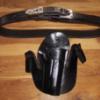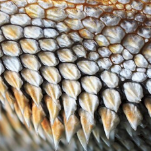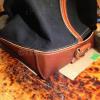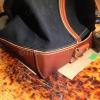-
Posts
1,540 -
Joined
-
Last visited
TinkerTailor's Achievements

Leatherworker.net Regular (4/4)
-
Hey Tinker I have a question for you, I have mixed my pure beeswax and neatsfoot oil 50/50 it is cooling as we speak. My question is what is the best thing to apply this with ( fingers, old towel, old t-shirt ) and how long do I wait before trying to buff this off ? and what is the best thing to buff it off with ? thanks Utah Leather
-

Don't know about TT, . . . but I put it on usually with my fingers, . . . first dose gets kinda smudged into the pores, . . . then a light once over with a heat gun, . . . add another coat, . . . smudge a bit more, . . . once again with the gun, . . . then polish, . . . and see how much more I need / want to put on to get the desired effect.
I also just grab the cake and start smearing sometimes, . . . kinda depends on my mood.
May God bless,
Dwight
-
-

Sorry, on vacation and didn't see this. I use my fingers as well. As far as buffing I wait until the product has started to get cloudy and is not shiney like when first applied.
-
-

order right & left skirting sides?
TinkerTailor replied to Squilchuck's topic in Saddle Construction
Yesterday I stopped into a local cobbler shop opened in 1959 and had tea with Rino, the 80 year old shoe maker owner . He is retiring, so I have taken every opportunity to pick his brain. He is legendary in the shoe industry, the stories he has are amazing....He once told me about a deal that fell through making Steven Tyler branded running shoes after he made a few pairs of boots for Aerosmith and they liked them. Yesterday he was telling me apparently the "newest innovation" in nike soccer cleats is laces on the side, which he invented in the 60's. .... Ironically yesterday he was just talking about laying out the pieces on a hide and how it is really the most important part of working with leather. He told me the biggest problem with the young guys these days is they do not pay attention to which part of the hide the pieces come from and which direction they layed in the animal. Every part of a hide stretches different and shoes with pieces cut wrong will be crooked. Not paying attention to this means you will have much higher waste. Throwing out bad leather before it is clicked is cheaper than throwing out completed uppers because of an un-noticed flaw in the leather. I could see where this idea could apply to saddles as well, If you have the shoulder on the front of the skirt on one side, and the butt on the front on the other, will the saddle stay symmetrical as it ages? Will the tooling look the same if it is on the butt on one side and the shoulder the other? These may be inconsequential details, but it may also be that cutting from both sides of the animal is one of those secrets that separates a master from a craftsman. Even if it doesn't make a better saddle, It also may be worth a percent or two less waste per saddle. For a guy making one at a time this is very little, and not worth the hassle of keeping rights and lefts in stock and sorted. However in a large production shop paying attention to this 1 or 2 % could mean dozens or hundreds of hides a year. Would not be the first time I have seen a "rule" that does not make sense in a one person shop, until you figure in economies of scale. -
Wood is unidirectional. It needs to be in the direction the tree grows. If you take a sheet of plywood that is 5 layers thick, it will be much stiffer and stronger parallel to the grain in the direction that has 3 layers going the same way. Any laminations with the grain direction the wrong way will crack. In addition, as moisture content changes wood only expands and contracts widthwide and not lengthwise. Having the expansion and contraction of the layers opposing each other can lead to glue joint failure. This is one of the reasons plywood left outside delaminates. Bowyers laminate in other omnidirectional materials like rawhide, sinew or fiberglass to counteract woods nature to split along the grain. The long and short of the leather laminate question is this: Full thickness, unsplit leather is stronger than split of equal weight, as listed in several textbooks. removing 1/3 of the thickness from the backside reduces the strength by half. Leather fibers are omnidirecional and do not run parallel like wood, meaning comparisons are not that accurate. Glue does not increase tensile strength. It maintains a cohesive bond so the 2 layers act as one layer. (there is engineering data for this.) Wood laminates are stronger because wood is unidirectional and 2 pieces with slightly differing angles to grain structure will triangulate each other when bonded. The omnidirectional nature of leather fibers intertwining means they do not have this property. The data supports that the surface grain does not add to strength. It does add to durability and resistance to contamination(which are a different topic), but not strength. The data also supports that the grain is harder to bond to, meaning face to grain glue joints are weaker and as such, a laminate of this type is likely weaker once the glue bond lets go, than a cohesive laminate that acts as a single layer would be. With that said, and assuming we are talking about unflawed leather, a belt made with 2 unsplit strips of 5 oz glued together back to back should be just as strong as a belt made from unsplit 10 oz. If it is stitched as well as glued, the stitching will add a small amount of strength but also pierce the leather as mentioned so to be a fair comparison the 10 oz would be need be stitched as well. In this case they should also be the same. A belt made with 2 layers of hide split to 5 oz will be weaker than a belt made from unsplit 10 oz. but likely are the same strength as leather split to 10 oz. As to the existence of the grain protecting the leather, longevity is a different question to strength.
-
This is a great design and is executed quite well. I like the little add on cell pocket on the gusset. I wonder if it is hand stitched or are the studs put on at the end after machine stitching? They are right on the stitch line on the front middle of the bag. Pretty hard to machine sew this with the hardware in place, and installing the hardware after would leave the prongs visible on the inside. If it is hand stitched, there is just enough room beside the hardware. Just curious, how was it done? The studs are not alot of work when you compare it to all of the stitching on the bag. Even by machine this is not an easy task to get all the stitch lines neat and parallel. Half of the stitch lines are doubled up. I would guess that there are 2 internal dividers based on the stitch lines. I would price it closer to 1000 with/without the studs myself, It is a pretty complex bag. If it did not have the dividers and the quick release straps and the cell pocket, i might go under a grand.
- 24 replies
-
- project
- lso angeles
-
(and 6 more)
Tagged with:
-

Hand stitching type? (not saddle for sure)
TinkerTailor replied to mayorblurps's topic in Sewing Leather
I do this stitch to join leather to canvas on one of my dopp kit designs: I find that single needle is much easier when dealing with several layers of canvas. Finding the hole in the leather from the backside with the needle can be a bear, so saddle stitch ends up way too slow. This photo is a few years old now. -
Depending on the hardness of the foot, the hacksaw may not cut and you just round off the teeth. If a file skates on the surface it is hardened and only carbide or abrasive cutting is going to be effective. Might get it done with a high quality lennox or starrett hacksaw blade, but the blade may not cut anything after. Those little red/maroon cutoffs for the dremel work great for slotting things. You can stack them up for thicker slots. Wear safety glasses. Those little wheels can come apart if you bind them in the slot with wigglelimp wrist....
-
I think it was more in reference to the forces/damage flexing the belt when going around the pulley being negligable compared to the forces lengthwise on the belt causing it to stretch. The grain has some effect on the belts longevity going around a pulley, and resisting bending damage, due to it holding the fibers tight while bending. The grain has much less effect on tensile strength because the flesh is the stronger part in this aspect as well it constitutes a greater portion of the thickness of the hide. I would imagine the treatments applied to the belting during tanning and manufacture have a much bigger influence on the ability of the belt to resist stretch and bending damage than the existence of grain.
-
This is one topic i have not looked into much but i believe most of the acrylic "leather" paints and products are no different from art store stuff thinned out. Just like sponges and gloves at tandy, if it is rebranded for leatherwork, it costs double. I did go through the msds sheets at TLFsafety.com and discovered most all of the ecoflo products are made by fiebings. I was specifically searching for the ingredients of the eco-flo cova color paints to see how they thinned the acrylics.
-
Do you have a link for that reference? i would like to add it to my library./ I looked ain a bunch of books for the section i remembered reading on drive belting, but I could not find it. I have read that they shaved/sanded/buffed the grain off when they layered skived hides to make thicker heavy duty drive belting. They would arrange them like a deck of spread out playing cards, with the hides half overlapped to get more thickness. The glue joint was not as strong grain to flesh as it was flesh to flesh, hence the removal of the grain. Also, as to the original question, Leather belting was never stitched only glued. The sections of belt were joined with stitching or clips, but the pieces are way longer than a hide is. The individual hides were glued together. I am sure if glue worked good enough here, it will hold up the that dirty hairy gun on yer belt I also have a few scientific journals that talk about leather tensile strength from the early 1900s but they are way too dry to read right now......
-
I could not find it in the Hasluck leatherwork book, but i did see referenced to his harness making book, which i have not seen. I did find this on page 30 of THE HARNESS-MAKERS ILLUSTRATED MANUAL., W.N.Fitzgerald, 1875: So well is this understood by leading harness- manufacturers who make up full lines, that they never cut a harness from a single side, but select the leather carefully and use a specific grade or weight for each particular strap; while the leading custom manufacturers purchase or cut only backs of the best quality. The great majority, however, buy their leather in small quantities, and by so doing commit the error of not procuring a proper assortment.As a rule, they select the weight best adapted to the greater portion of their work, and when lighter stock is needed they resort to the splitting-machine, entailing on them- selves extra labor, and wasting no inconsiderable amount of leather, besides materially weakening the straps thus manipulated, as the portion of the flesh side which is removed is the strongest part of the stock.
-
I have a library of hundreds of pdfs of old leatherworking and tanning textbooks. I have aquired these from many places on the net over the years, some i forgot where and many have disappeared behind paywalls and are not available to view without memberships. This information is in quite a few of them. You can find a few books on archive.org if you look around. I would post the pdfs here but they are all way too huge. Some are 100mb.... From "The manufacture of leather" by Allen Rogers, PHD , printed in 1922: (sorry for the formatting) 4. Analysis of Skins. — At first glance, the pelts of various animals appear to have little in common. On closer examination, however, a very close similarity will be observed. In structure, all animal skin is made up of several readily defined layers. The skin is not merely a covering for the animal, but also serves as a container for nerves and secretive glands, and as a bed, or ground, for the hair, or fur. It is made up of two principal layers : the epidermis, or cuticle, and the corium, or tnie skin. These two layers are totally distinct in structure, origin, and functions. 5. The epidermis is a thin covering of the true skin and is entirely removed before the tanning operations begin. In life, the upper, or external, part is being constantly worn away, falling off in the form of dry scales. The interior part of the epidermis is made up of numerous living nucleated cells ; as the surface of this layer is reached, these cells become flattened and finally dry up and form the exterior part of the epidermis and ultimately drop off as dead scales. These cells, which renew the horny external tissue of the epi- dermis, are in turn renewed by vessels situated in the corium, or true skin. The epidermis does not combine with tannin and is therefore removed, laying bare the true skin, which is known to the tanner as the grain. 6. The corium, or true skin, is the skin with which the tanning agents combine to form leather. There is an inter- mediate albuminous layer between the corium and the epidermis. Both layers are composed of interlaced bundles of fiber running across and above one another and parallel to the surface of the skin. These fibers are surrounded by fluid matter, which serves to keep the skin in a moist and pliable condition. On removal of this fluid the fibers alone remain, and if dried by a gentle heat they assume a horny appearance and become in substance about one-third of the raw hide. The corium determines the quality of the leather that can be made from a hide. Its thickness, flexibility, and strength are reproduced in the leather. Between the fibers of the corium is an albuminous substance called coriin: in a dry state this holds and connects the fibers. The connective tissue of the corium gives form to the skin, the intercellular substance, coriin, lying between the fibers. When boiled with water, these connective tissue fibers form glue, losing their organized structure, and making a homo- geneous jelly. 7. The intercellular substance is probably a decomposition product of the connective tissue. This coriin is soluble in lime water and other alkaline solutions ; frequent treatment of the skin with these reagents withdraws fresh quantities of soluble matter with every treatment. This fact should be noted in connection with the liming of skins to remove the hair. Dilute inorganic acids swell the connective tissue. The swelling of the skin by acids is made use of to facilitate tanning ; it not only makes the skin more sensitive for the reception of the tanning material, but also effects the disintegration of the fiber bundles into individual fibers, thereby increasing the surface. 8. The under skin is made up of loose connective tissue, embedded in which are the sweat and fat glands, the blood vessels, and muscular fiber. Fig. 1 shows an enlarged micro- scopic transverse section of the skin in which the Malpighian net, or lower layer of the epidermis, is shown at d ; the corium,
-
This is also why the old books say a strap is best from unsplit leather, as mentioned above. These coarse fibres are also long, and intertwined, which is where the strength comes from. Same idea makes cotton fibers strong when woven into denim. Splitting cuts these fibers shorter. Shaving denim thinner and then doubling it up will not be anywhere near the strength of thicker denim.
-
When making anything out of leather the labour time is the big cost. Leather a small amount of the total cost of an item. Depending on the item and work involved, the leather cost could be as small as 5% or less of the item cost with labour. Shoes, wallets and tooled items can easily be like this, a whole bunch of work on small pieces of leather. Some of the larger, simpler bags i make are closer to 20% material, Not sure how a saddle fits in this spectrum however i would guess 15-25% material cost is close because there is a lot of square footage per item. Adding labour time fighting with substandard materials and redoing work due to hidden issues is very costly. It is false economy. Double the price/quality of the leather on a labour intensive item like a complex tooled wallet you wholesale for $100 dollars, which has a 5% material cost and it only adds $5....Moving even 10% slower will be more costly.....that is only 6 mins per hour. If you are selling items, upgrades, upgrades, upgrades.......anything you can change without adding significant labour time should be offered as an upgrade, for a charge. I set price based on customer material choice to account for this. I have a base price and upgrades. If I upgrade a bags leather, I add some profit to the increased material cost for that bag and make that the leather upgrade charge I pass on to the customer. Low labor upgrades are a great way to increase overall profit margin, if priced correctly. For instance, if you make wallets you could offer black, brown or white thread standard and charge $10 for the blue, green, red, purple contrasting stitch upgrade. The thread cost is the same, but profit on the item is 10 dollars higher.
-

My very first leather holster
TinkerTailor replied to carguy4471's topic in Gun Holsters, Rifle Slings and Knife Sheathes
Forming and getting the item to set is a moisture content thing. As you probably have figured out when hard forming as you call it, there is a magic window between sopping wet, where it conforms but wont hold a shape and too-dry where it won't form at all. Fortunately the window is pretty big. If you can pinch drops of water out of the leather easily, it may be too wet, wait a bit before forming. at the right moisture content once it forms to shape there is really no reason to have it in the bag, as it needs to dry to set the shape, and this can not happen in the bag. -
I hate that brush. When the can is full, i spent so much time scraping the excess off the shaft above the brush to prevent drools and drips that i gave up and cut the brush off. Along with the pallette knives i suggested above, I also still use the same acid brushes Dwight recommends for bigger areas, and belts especially. The acid brush attached to the lid of the can is way too much of a sticky booger mess for me. It either drips on the project or you hold it brush up and fill the cap of the can with glue...Since i started cutting the brushes off, and using disposables, i have had no problems with the caps gluing on, as I am not dripping glue on the threads while scraping the brush shaft and filling the cap holding it upright. Btw, I rub the threads of new glue cans and lids with a little paraffin wax to prevent the glue from sticking to them.





